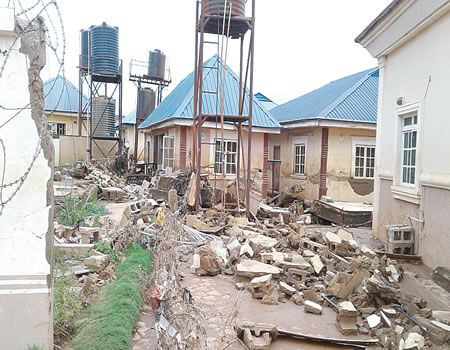WHEN the Nigerian Metrological Agency (NiMet) predicted in its 2019 Annual Flood Outlook that many parts of the country were going to experience low rainfall this year, those who live in flood-prone area must have heaved a sigh of relief, believing that their fears for the rainy season this year were unfounded after all.
Though Abuja the federal capital was not mentioned as one of the areas likely to experience flooding in the course of the year, parts of the area are currently experiencing flooding or are under its threat.
Lokogoma District of the FCT is also one area which has experienced its own share of flood disaster this year. EFAB Estate, a serene environment, located in the district has partially become a ghost town, most especially Road 105 part of the estate.
The nasty experience of devastating flood in the area in particular has literally sent residents fleeing, making them internally displaced persons who are currently taking refuge with friends and relations in different places.
Due to the impact of flooding and gully erosion in the area, one of the two major bridges connecting roads in the estate has collapsed making the roads impassable for vehicles. The second one is in a sorry state.
To date flooding had been recorded in Lokogoma District of Abuja on June 6, June 26, July 25 and August 2. On all these occasions residents had their hearts in their mouths when the rains came down in torrents and their streets were flooded.
Piqued by this situation the Department of Development Control (DDC) of the FCT began to demolish houses built on water ways, but the flood has not abated.
However, one of the victims of the Efab Estate flood disaster, a 62-year-old retiree, Mr. Michael Edoja of House 11, Road 105, told Sunday Tribune that most residents had fled the area, due to constant flooding. He said a resident recently lost a 17-year-old boy, who was trapped by the flood. Several properties and household items were also lost to the flood.
Mr. Edoja, who is also the secretary, landlord association of the estate, said he would have wished to relocate if he had the wherewithal, but he didn’t. He lamented that with his meagre pension, he could not secure a bank loan while blaming the federal government for lack of support through the National Emergency Management Authority (NEMA).
According to him, “people have moved out of this area because of flood; so we have to resort to self-help. When it rains, water would come in. Government came with their machinery, the development control agency came to pull down houses but flooding has not abated.
“We thought and hoped that immediately they pulled down the barricade, the problem would be solved, but whenever the water gets to the culvert, it would then begin to flow back. As they pulled this (structure) down, we expected them to open up two more culverts so that water can flow seamlessly.
“You can see now that people leave their various homes anytime it rains. We often return later to come and check the house. We are now internally displaced persons in our own country. It is so pathetic.
“It was by the grace of God (that we have survived) because once, we were almost trapped inside by the flood. We hung up (on the ceiling) with my little baby (Oluwatobi) hanging on my neck. These houses were built under the Mass Housing Programme of the FCT and I bought my house in 2010, moved in 2011 and for houses to be here for more than ten years, do you want to tell me government is not aware?
“If they said we don’t have approval, what is government agency doing? If the building has been standing here for years, suddenly you just woke up and said it was not approved, who is to blame? It is their negligence. Water from all over the district passes through the canal here. So the government is supposed to do proper channelisation, it is not just about demolition alone,” he submitted.
Another victim, Bisong Canaan who has been devastated over the effect of the displacement his family has faced said the flood was a great disaster adding that more than 15 houses and two churches were submerged. He, therefore, called government through NEMA to come to their aid.
However, the Director-General of Nigeria Hydrological Services Agency (NIHSA), Clement Nze, has blamed the incessant flooding on failure of relevant stakeholders and state governments to heed to the warnings issued before the onset of rainy season in the country.
He explained that daily records from the agency’s hydrological measuring stations across the country showed steady rise in water levels.
“Particularly, the hydrological measuring station downstream the confluence in Lokoja, Kogi State shows the likelihood of spread of damages that may arise from flooding incidents in 2019,” he warned.
He revealed that more states would still be affected by river and urban flooding as flood from the upper reaches of the Niger Basin would be arriving Nigeria in a month’s time.
“Flooding incidents started manifesting early in states such as Niger, Lagos, Edo, Imo, Abia, Jigawa, Adamawa, Delta, Rivers, Oyo, Enugu, Kebbi, Nasarawa, Bauchi and FCT.
“There is high probability that more states would still be affected by both river flooding and urban flooding as flood from the upper reaches of the Niger Basin (Guinea, Mali, Niger, Burkina Faso, Cote d’Ivoire, Benin, Chad and Cameroon) would be arriving Nigeria in a month’s time.”
“The localised urban flooding incidents being witnessed in some cities and communities in the country are expected to continue due to high rainfall intensity of long duration, rainstorms, blockage of drainage system and poor urban planning resulting in erection of structures within the floodplains and waterways,” he added.
Nze then called on all states and local governments and stakeholders to endeavour to remove structures built within the floodplains, clear blocked drainages, culverts and other waterways.
Despite the demolition of 150 structures in the FCT to open up the waterways, the administration has decided to demolish more houses.
FCT Permanent Secretary, Sir Chinyeaka Ohaa, who made known this latest step in Abuja during the Stakeholders’ Forum on Flood Mitigation and Response Coordination, said the FCT administration would continue to remove structures constructed in violation of relevant laws and further complicate the flood risk.
“So far, 150 of such structures have been removed in furtherance of the on-going exercise to clear obstructions of waterways, in line with the Abuja city plan,” he emphasIsed.
The permanent secretary, however, regretted that despite repeated sensitisation and awareness programmes, many residents still dump waste in drainages and other prohibited locations which resulted in constriction or blockage of waterways.
Mr Ohaa, therefore, urged the committee to come up with watertight preventive and response strategies against the impending flood and also proffer durable solutions to the issue of recurrent flood in the FCT.
WATCH TOP VIDEOS FROM NIGERIAN TRIBUNE TV
- Let’s Talk About SELF-AWARENESS
- Is Your Confidence Mistaken for Pride? Let’s talk about it
- Is Etiquette About Perfection…Or Just Not Being Rude?
- Top Psychologist Reveal 3 Signs You’re Struggling With Imposter Syndrome
- Do You Pick Up Work-Related Calls at Midnight or Never? Let’s Talk About Boundaries







